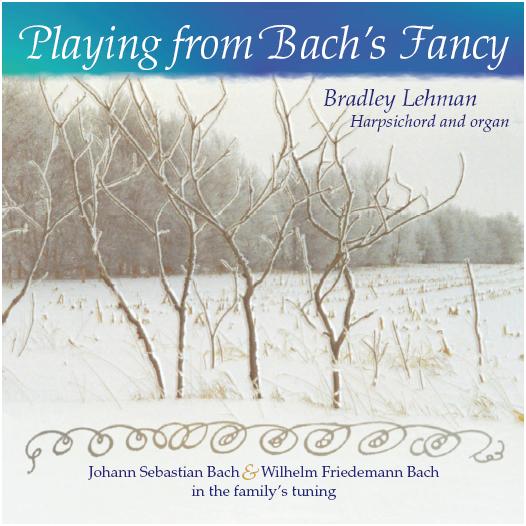 LaripS.com, © Bradley Lehman, 2005-22, all rights reserved. All musical/historical analysis here on the LaripS.com web site is the personal opinion of the author, as a researcher of historical temperaments and a performer of Bach's music.
"Ordinary" Temperament"Ordinary" temperament, or temperament ordinaire, is a typically 17th century manner of tuning. It starts from regular tuning, i.e. "meantone", where the notes are evenly spaced (regular)....Ebb, Bbb,That is an endless spiral, extending in both directions. All those fifths are the same size, hence the regularity. They are all narrower than pure fifths by some consistent amount, which might be (most typically) 1/4 comma, 1/5 comma, or 1/6 comma. These regular systems are called "meantone" because the resulting major thirds are split exactly in half ("mean", average), having two tones exactly the same size. For example, C to D is the same size as D to E, making up the major third C to E. Mean tone. The tones are generated as two fifths each, and those fifths are of consistent size, so the tones are also of consistent size. And, since there are only twelve notes per octave on most keyboards, we have to choose the twelve notes from the spiral that we use most often in music. Normally that is this set: Eb, Bb, F, C, G, D, A, E, B, F#, C#, G#It provides a complete C major scale, plus the most frequently used accidentals nearby, all generated by a series of consistent (equally sized) fifths. The big trouble with it is this: the Eb and G# make nothing resembling a fifth at the ends. It's a diminished sixth. It's so far out of tune, if we pretend to use it as a fifth, that it has the name "wolf". Likewise, there are some wrongly spelled major thirds in there: G#-C, C#-F, F#-Bb, and B-Eb. They're not only spelled incorrectly on paper, but they don't sound like decent major thirds. They, too, are wolves. They're really diminished fourths, not major thirds at all. That difference must be bridged somehow, so music can be played using these as well. That's the basis of regular temperament. Eleven regular fifths, and one "wolf" fifth. Eight regular major thirds, and four "wolf" diminished fourths. Starting from that, temperament ordinaire is a tasteful modification of that. It's a tempering strategy to make more notes usable than merely the twelve most common ones. It fudges off that regularity so there is a smooth transition connecting the ends of that set of twelve, and so all of the major thirds and the fifths become usable, no wolves. Music can then be written using all the possible note names, not only the middle twelve nearest C major, and with the expectation that it will sound at least decent. The naturals are kept at or very near their regular positions: especially the C, G, D, A, and E. At the left end of the line, Eb and Bb (and sometimes also at F), it is normal or "ordinary" to lower these notes slightly. And at the right end of the line, in the sharps (and sometimes also at B), they are raised slightly. These formerly regular fifths at either or both ends turn into irregular fifths, compared with our basic fifths in the center, the naturals. These new fifths are less tempered, i.e. somewhat widened toward purity; sometimes they're even pure. And sometimes one or more of them even become slightly wide instead of narrow! This is especially so at F-Bb, Bb-Eb, and/or Eb-Ab. But the basic concept to grasp here is that they are stretched, away from the regularity of the core fifths. "Ordinary" temperament is also called "modified meantone". This process metamorphoses gradually into the temperaments that are called "circulating" or "good" or "irregular" or "semi-regular" or "well temperaments" (although that last name is ungrammatical). That strategy of ordinaire becomes the result that a whole family of temperaments evolved by tastefully raising sharps, and/or lowering flats, until the set of twelve notes meets itself nicely enough that more scales/chords can be played without disaster. A collection of representative temperaments, mostly of this "circulating" or "good" variety, is presented at the comparisons page. That's "ordinary" temperament, again, from the perspective of the 17th century and looking forward into the 18th. The natural notes are still regular: that's where singers and non-keyboard players expected to find them, evenly spaced, regular. The irregularities happen in the sharps/flats, and the connection points (B and/or F).
"Extraordinary" Temperament"Extraordinary" is a new term I have developed as a convenient way to describe the Bach temperament (as I have presented in the article), Sorge's 1758 temperament, and several in Neidhardt's 1732 set (see this set of analytical tables). They go beyond the ordinary. They have the same strategy of "ordinary" temperament back through the "good" or "circulating" temperaments, as explained above...but they do even better in all tonal music than the others do.The fundamental difference, and the reason they work so well, is this: the major third E-G# is wider than the major third Ab-C. The tasteful adjustments have to be somewhere. These "extraordinary" layouts put those adjustments mostly into the sharper sharps, where the "ordinary" layouts handled it mostly in the flatter flats. Compare these three views of Bach's temperament, which are identical to one another in placement of the notes: 1. Eb -1/12 Bb +1/12 F -1/6 C -1/6 G -1/6 D -1/6 A -1/6 E 0 B 0 F# 0 C# -1/12 G# (-1/12 Eb).It's a closed set of the same twelve notes, wrapping around to meet itself, with sharps reinterpreted as flats, and vice versa. The regular fifths (tempered -1/6 each) are as normal. F-C-G-D-A-E as the ground plan. And the "ordinary" process is done to the others:
How is this extraordinary? With the resulting major third E-G# slightly wider than Ab-C, and smooth transitions to get there in either direction (through the nearby fifths and major thirds), the old expectation from regular temperaments is thrown out the window. That quite reasonable expectation was that the "wolf" major thirds G#-C, C#-F, F#-Bb, and B-Eb should be of worse quality than the correctly spelled major thirds, the other eight. As is shown by playing tonal music in these "extraordinary" layouts, tonal harmony and melody work remarkably well when we're not tied down to that old expectation about those four major thirds. Instead of merely nudging sharps up and flats down to compromise the problem, as the ordinary halfway solutions do, these "extraordinary" temperaments throw the whole problem itself out the window, by discarding its premise! The same process of nudging, with slightly different proportion and pattern, yields an "extra-ordinary" result: the premise about those four typically "wolf" major thirds (and their quality relative to the others) is discarded as untenable, in favor of better behavior in tonal music. This discarding of the old regular-meantone premise about those four major thirds? It's a paradigm shift. The Bach family temperament made that shift. Why is it logical to have E-G# wider than Ab-C, i.e. to have the note Ab/G# closer to C than to E in its tuning? It took me some months to realize this, but I now have a simple theoretical explanation: Ab is only four steps around the spiral of 5ths from C (C-F-Bb-Eb-Ab), while G# takes eight steps to get there (C-G-D-A-E-B-F#-C#-G#). Therefore it's reasonable to have Ab better in tune (with respect to C) than G# is! The fact that most of the other 18th century temperaments do not do this is neither here nor there. Those generate their own effects, and this one is different. See also a graph of the enharmonic handling and the scale structure, explaining (more visually) how this works. My remarks about Neidhardt's 1732 "5th-circle #11", another of these "extraordinary" layouts with E-G# wider than Ab-C, are in my review of the Lindley/Ortgies article. Jean-Philippe Rameau's published preference in 1726 was apparently for a system with regular 1/6 comma tempering in Bb-F-C-G-D-A-E-B, and the other four notes tastefully arranged to fill the gap. My presentation of this is in section 6 of the "practical instructions" page.  |
v Introduction v Articles v FAQ v Practice > Theory - Measurements - Comparisons - Other "Bach" * [Extra]ordinary - Regular/Mean - Enharmonics - Cube puzzle - Geometric 5ths - TU & Schismas - Fa Ti Modulation v History v Etc v Recordings |


